Summary:
We had a great ice year on Lake Champlain. We have been able to skate to places we normally can't get to either for too much snow or lack of skatable ice. The ice has also reminded us of a few things: more respect for big ice, that ice is constantly evolving and it often has unexpected surprises.
- Three partial immersions and three full immersions.
- Two impact injuries from carrying things in front pockets. Both resulted in the loss of a couple weeks of the skating season.
- One example of hard falls on skates resulting in significant head impact that most likely would have resulted in a concussion without a helmet.
- There was a fatality in New Hampshire although ice was an incidental factor. Click here for more information.
****************************************************************
Breakthroughs
The breakthrough occurred just above the center of this pictur. The nearest crack is an ice-bulge crack formed by the heating of the top of the ice sheet. The crack system at the breakthrough may have been a small folded ridge.
Close up
On January 24 , three experienced and well equipped skaters were on three day old ice on southern Lake Champlain. The three days had been below zero and the ice sheet had grown to 3+inches. One of the skaters was crossing some ice bulge cracks when the plate broke. He twisted and leaned to the side and only went in to his waist. He was wearing a dry suit. The only difficulty was frozen skate bindings at the end of the day.
Loose or breakable pieces of ice are fairly common around converging cracks and minor ridges on new ice.
**************************************************************************************
February 1, 2014: Reports of great skating around the Palisades got a lot of weekend skaters on the ice, some of them in places that had not been well explored. A mild, one day warm up on Friday put new expansion pressure on the ice sheets resulting in new or activated ridges.
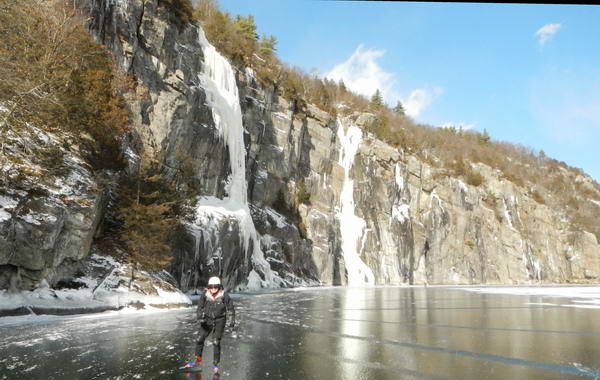
The Palisades-same guy-different day
A swim occurred near the Palisades by an experienced skater who was reviewing pictures on his camera while he skated into a folded ridge. Having been there three times in the previous week he was not expecting the ridge or to need his dry suit. The suit would have made the four mile trip back to the car more comfortable but even without it he was able to stay reasonably warm (it was a warm, light wind day).
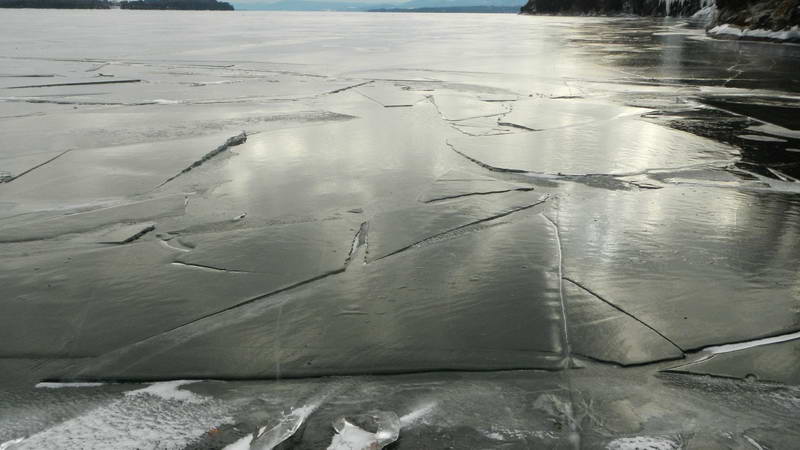
This is the same ridge two days after the swim. It is now a partially refrozen loose plate ridge.
Several ridges, including this one, formed within 36 hours of the accident.
Cold water protective clothing is a lot like wearing a seatbelt: it is difficult to predict when it will be needed
**********************************************************
February 1, 2014
A person fell through to the waist in an 18" wide wet crack that looked a lot narrower than it was. She made a quick exit and had a change of dry clothes, allowing her to continue on.
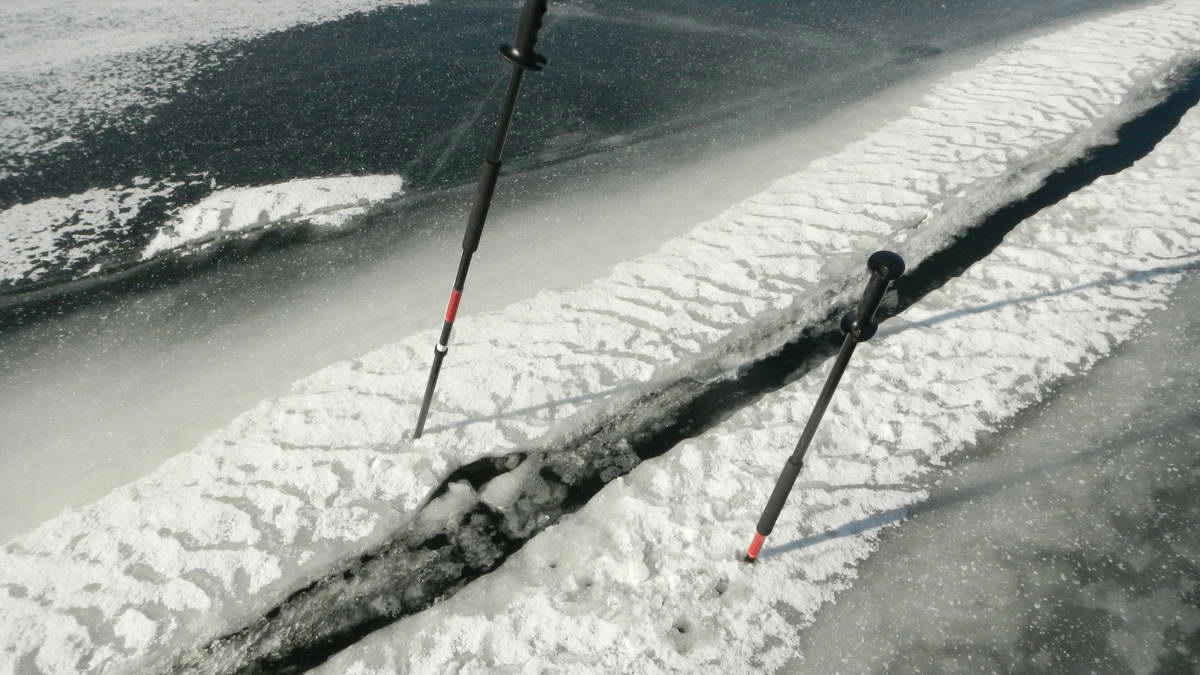
The wide wet crack is as wide as the distance between the poles. The white snow band ice over the crack is weak.
******************************************************************
February 1, 2014
A solo skater skated into a large hole which may have had a thin layer of overnight ice.
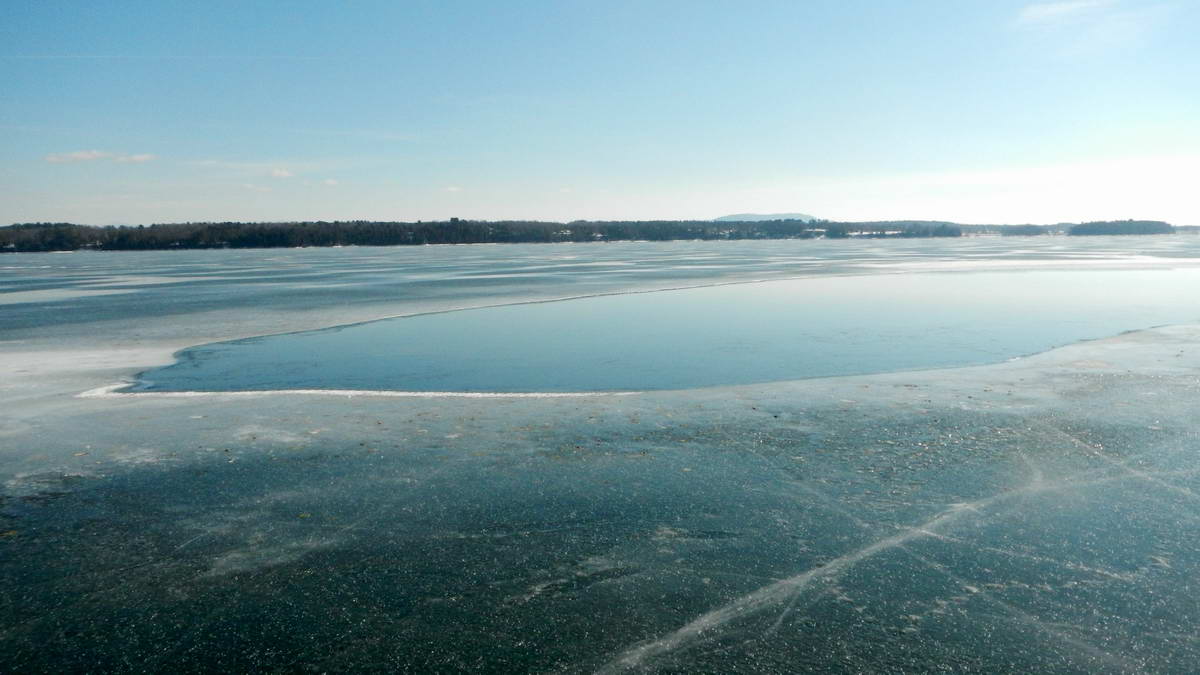
This is the smaller of two holes that are kept open, at least in part, by large numbers of Geese . This one is about 50 ft wide and 150 feet long and is where the accident took place. The other is about 200 feet wide and 700 feet long.
He wore his red ice fishing claws around his neck. They got lifted over his head as he fell in and, once they were loose, they sank! He got out by using his skating poles as ice claws.
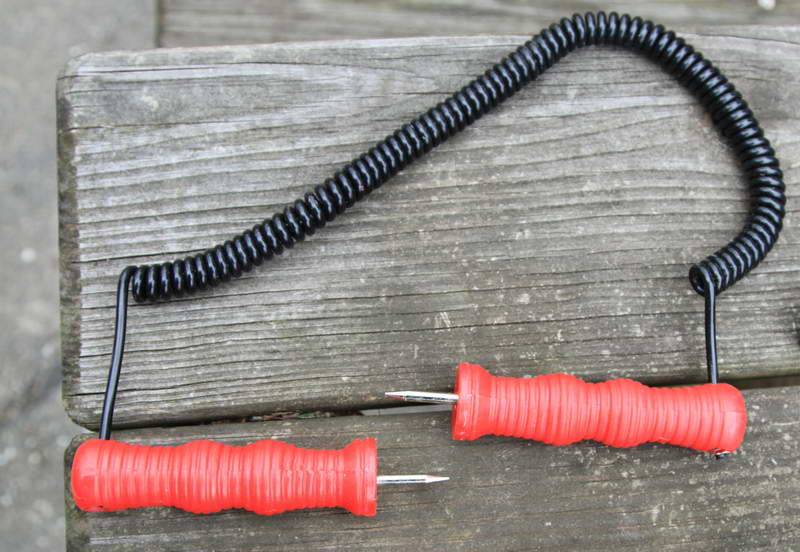
The ice claws you can buy where ice fishing gear is sold work well but have a significant drawback. All the fishing types sink.
He also lost one skate in the process, making getting back to shore difficult (he now recommends always carrying foot traction). This was a clear affirmation about something we all know: Skating alone gives flexibility on when and where you skate but it provides little safety margin if things go wrong as they inevitably will.
The origin of the large holes is a bit of a mystery. The ice had come in on about January 22 and temperatures had been below freezing until Jan 31 when it got up to 34 degrees followed by 38 degrees the day of the accident. Two days with daytime temperatures only a few degrees above freezing does not seem to be any where near enough to make such huge holes in 6+ inch ice. I scared up about 200 geese when I approached the holes three days after the accident. That does not seem like enough birds to keep the holes open in the consistently cold weather between freeze up and the accident. Maybe many more geese were involved or maybe the 40 mph winds we had on two days about a week after the freeze up ripped out the holes however we did not find any rubble bands that would indicate a rip-out, the holes were also not the right shape. The 'lots of geese' explanation is the best but far from certain.
****************************************************************
February 1, 2014
A solo ice bike rider broke through on his return trip over a ridge on the north shore of Thompson's point. He had watched (from a distance) as several skaters crossed the ridge at what they deemed to be a reasonable crossing point. He headed there and crossed the ridge successfully. About 40 minutes later he came back following his earlier stud tracks across the ridge. He broke through.
Meanwhile two skaters were trying to cross the same ridge and having a difficult time finding a place to cross. When they saw the rider approaching the ridge they thought he had found a good place. They headed over to the crossing point and got there just after the rider fell through.
He was wearing a Mustang Deluxe anti-exposure coverall and worksuit. The suit had plenty of flotation, allowing him to hang onto his bike rather than letting it sink. The suit also kept him pretty dry (he only got wet to a little above his ankles) so he was not in the usual hurry to get out. He attempted to throw a rope to the skaters but the rope had not been properly coiled. The skaters weighted throw bag did the trick. The biker and his bike were easily rescued.
The ridge in this accident was probably a folded ridge with a thin layer of ice over the open water in the ridge. The temperature on February 1st peaked at 38 degrees and there was sun until about noon. That could have progressively weakened the ice and it is likely that the ice became fatigued by several people passing over the same spot ice. A test pole would have indicated that the ice was thin/weak.
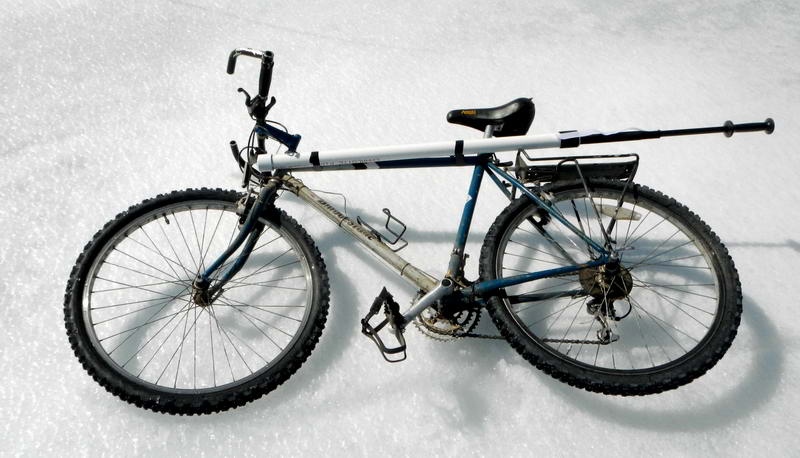 Ice bike with a test pole carrier taped to the top tube. The carrier made with PVC pipe, a piece of rag is stuffed into the closed end to protect the pipe from the pole tip. Sticky-back and sew-on velcro tape is used to retain the test pole in the carrier.
Ice bike with a test pole carrier taped to the top tube. The carrier made with PVC pipe, a piece of rag is stuffed into the closed end to protect the pipe from the pole tip. Sticky-back and sew-on velcro tape is used to retain the test pole in the carrier.
Ice bikes have a reputation for taking their riders swimming. If most riders were to carry a test pole and take the time to dismount and use it on all suspect ice there will be a lot less swimming.
******************************************************************
April 9, 2014, Shelburne Point VT
The dark patch in the lower center is where I stepped through.
I was checking out some very well thawed ice with white layer of corn ice on the surface. I stepped on some rotten candled ice that dropped me through. I twisted and leaned to the side as I fell in and only went through to my hips. Of course I was in my dry suit, had a life jacket, claws, cell phone and a test pole. I was solo (its hard to find properly equipped people who are also inclined and available to explore rotten ice). I was also within earshot of several people working on the shore.
**********************************************************
Injuries:
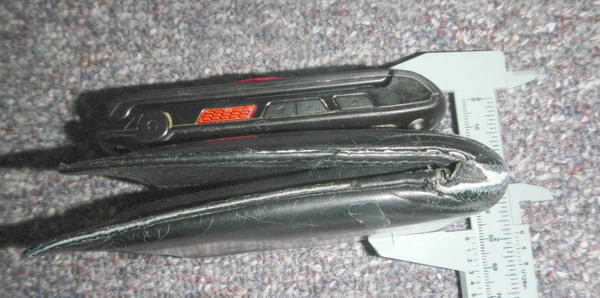 Wallet and cell phone
Wallet and cell phone
In late December, at the end of a long trip, I was skating in a 10-15 mph crosswind. I was using my poles for extra propulsion. I undercompensated for the wind and planted my upwind pole in front of my skate and took a hard fall. I had a two inch stack of wallet and cell phone in a front pants pocket. It was driven hard into my thigh. It took three weeks to get back to skating condition.
*****************************************************************
In January another experienced skater took a hard fall with a soft plastic water bottle in a front jacket pocket. She had persistent pain in the days afterwards. Her doctor ordered an MRI which showed she had lacerated her liver.
Lessons: (the first two are from the victim in the water bottle fall).
- "Don't become complacent about those "fluffy" little snow patches. We'd cruised right through countless of them for 17 miles before I hit the one that stopped me cold, at speed, and slammed me to the ice."
- "It is not a good idea to keep anything in pockets. If I hadn't had that water bottle in my pocket I might have rung my clock, but most likely I wouldn't have done any real damage."
- Carrying anything in front of you is a source of focused injuries. Everything should be in a pack or off to the side. Even car keys can be a problem.
- Big things carried in front are even more of a risk. Cameras of all sizes are often carried in front as are front packs.
- Poles are used too much by most North American skaters. When poles are used they should be planted with care. Planting poles further back and more to the side than will reduce the tripping risk. If it is windy it is important to compensate for the amount the wind will blow the upwind pole toward your skate. If you are double poling every other skating stride, make the plant whan you are pushing off onto the downwind skate. That way the wind will blow the downwind pole away from the more vulnerable skate.
- We all take hard falls occasionally. One every 20 trips seems about typical.
****************************************************************

Looking north from Charlotte Town Beach toward the Four Brothers Islands (7 miles away) the returning skaters are a mile or two away (picture taken with a long lens).
February 17, 2014
One of our stronger skaters was out with some even stronger skaters on a 27 mile exploratory trip on less than great skating ice. Among other things it had a fair number of slush bands, a few of which were not completely frozen. He took two hard falls on the return trip. They were a result of breaking through the crust on the partially frozen snow bands. In both falls he hit his head hard on the ice. He was very happy to be wearing a helmet. and he felt that he would have had a concussion if he did not have a helmet on.
- Helmets continue to show themselves to be important safety equipment for skating.
- Snow bands are effective at generating hard falls. It is often the case that a small fraction of them are not fully frozen. After skating over a bunch of then without having any problems it is easy to get careless about how fast you can skate over them.
- Groups of strong skaters can be hard on each other.
- As shown in three accidents reported here, the end of long trips over confidence, sloppier technique and/or lack of attention lead to greater risk of a fall.
